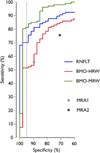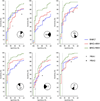Enhanced detection of open-angle glaucoma with an anatomically accurate optical coherence tomography-derived neuroretinal rim parameter
- PMID: 23265804
- PMCID: PMC3667974
- DOI: 10.1016/j.ophtha.2012.09.055
Enhanced detection of open-angle glaucoma with an anatomically accurate optical coherence tomography-derived neuroretinal rim parameter
Abstract
Objective: Neuroretinal rim assessment based on the clinical optic disc margin (DM) lacks a sound anatomic basis for 2 reasons: (1) The DM is not reliable as the outer border of rim tissue because of clinically and photographically invisible extensions of Bruch's membrane (BM) inside the DM and (2) nonaccountability of rim tissue orientation in the optic nerve head (ONH). The BM opening-minimum rim width (BMO-MRW) is a parameter that quantifies the rim from its true anatomic outer border, BMO, and accounts for its variable orientation. We report the diagnostic capability of BMO-MRW.
Design: Case control.
Participants: Patients with open-angle glaucoma (n = 107) and healthy controls (n = 48).
Methods: Spectral-domain optical coherence tomography (SD-OCT) with 24 radial and 1 circumpapillary B-scans, centered on the ONH, and confocal scanning laser tomography (CSLT) were performed. The internal limiting membrane (ILM) and BMO were manually segmented in each radial B-scan. Three SD-OCT parameters were computed globally and sectorally: (1) circumpapillary retinal nerve fiber layer thickness (RNFLT); (2) BMO-horizontal rim width (BMO-HRW), the distance between BMO and ILM in the BMO reference plane; and (3) BMO-MRW, the minimum distance between BMO and ILM. Moorfields Regression Analysis (MRA) with CLST was performed globally and sectorally to yield MRA1 and MRA2, where "borderline" was classified as normal and abnormal, respectively.
Main outcome measures: Sensitivity, specificity, and likelihood ratios (LRs) for positive and negative test results (LR+/LR-).
Results: The median (interquartile range) age and mean deviation of patients and controls were 69.9 (64.3-76.9) and 65.0 (58.1-74.3) years and -3.92 (-7.87 to -1.62) and 0.33 (-0.32 to 0.98) dB, respectively. Globally, BMO-MRW yielded better diagnostic performance than the other parameters. At 95% specificity, the sensitivity of RNFLT, BMO-HRW, and BMO-MRW was 70%, 51%, and 81%, respectively. The corresponding LR+/LR- was 14.0/0.3, 10.2/0.5, and 16.2/0.2. Sectorally, at 95% specificity, the sensitivity of RNFLT ranged from 31% to 59%, of BMO-HRW ranged from 35% to 64%, and of BMO-MRW ranged from 54% to 79%. Globally and in all sectors, BMO-MRW performed better than MRA1 or MRA2.
Conclusions: The higher sensitivity at 95% specificity in early glaucoma of BMO-MRW compared with current BMO methods is significant, indicating a new structural marker for the detection and risk profiling of glaucoma.
Copyright © 2013 American Academy of Ophthalmology. Published by Elsevier Inc. All rights reserved.
Figures






Comment in
-
Detection of glaucoma with an optical coherence tomography-derived neuroretinal rim parameter.Ophthalmology. 2013 Nov;120(11):e78. doi: 10.1016/j.ophtha.2013.07.024. Ophthalmology. 2013. PMID: 24182570 No abstract available.
-
Author reply: To PMID 23265804.Ophthalmology. 2013 Nov;120(11):e79. doi: 10.1016/j.ophtha.2013.07.023. Ophthalmology. 2013. PMID: 24182572 No abstract available.
References
-
- Hogan MJ, Alvarado JA, Weddell JE. Histology of the Human Eye: An Atlas and Textbook. Philadelphia, PA: Saunders; 1971. pp. 538–540.
Publication types
MeSH terms
Grants and funding
LinkOut - more resources
Full Text Sources
Other Literature Sources
Medical
Miscellaneous

